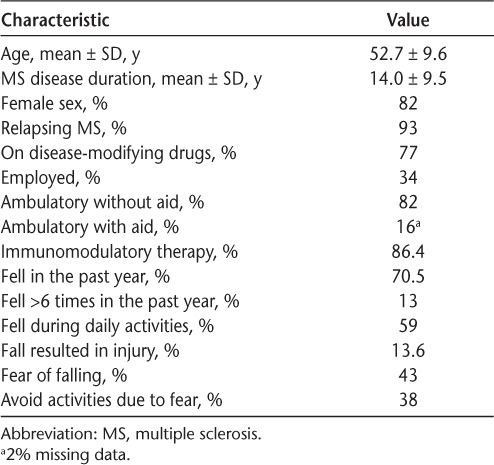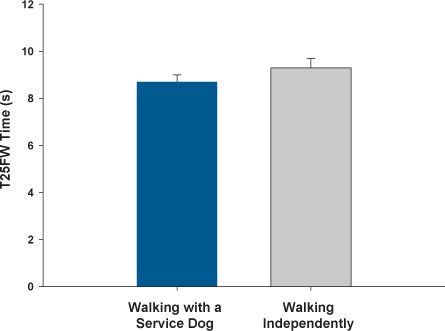To the Editor
Walking impairment and physical inactivity are major concerns for individuals with multiple sclerosis (MS), with mobility being reported as the highest functional priority for 65% of patients with MS.1 Gait alterations can include slower speed, shorter stride length, and decreased distance walked, giving the individual the perception of decreased ability to perform activities of daily living.2 Service animals are increasingly being recognized as productive aids to individuals with a variety of neurologic disabilities. Service dogs are trained to do a range of tasks from retrieving objects to opening doors, pulling manual wheelchairs, and performing simple tasks at home that assist with activities of daily living. We designed a study to determine the immediate effect of the assistance of a service dog on walking speed in individuals with ambulatory dysfunction secondary to MS.
Methods
The convenience sample comprised 44 individuals with identifiable gait abnormalities secondary to MS who were able to ambulate safely without the use of an assistive device even if they used one intermittently or on a regular basis to compensate for imbalance or motor deficits. Participants completed an informed consent form approved by the Oklahoma Medical Research Foundation institutional review board (Oklahoma City) before testing.
Each individual performed two sets of Timed 25-Foot Walk testing (T25FW) at a fast but safe speed separated by 15 minutes of rest time. Each set involved one unassisted walk and one walk with the service dog, with 3 minutes of rest time in between. The second set was in the reverse order, walking with the service dog first. The dog was trained to walk beside the participant, so as not to pull or lag behind, and had a special harness with a flexible handle to eliminate the option of leaning on it for support. The usual dog handler walked on the opposite side to ensure compliance by the dog and to eliminate a potential influence from lack of experience with dog handling by the patient.
The results of all descriptive analyses are reported as mean ± SE. A paired-samples t test was used to examine the difference between walking with and without a service dog. Statistical analysis was performed using IBM SPSS Statistics for Windows, version 20.0 (IBM Corp, Armonk, NY). Statistical significance was defined as P < .05.
Results
The demographic characteristics of the participants are presented in Table 1. There was a significant difference in mean ± SD T25FW times, with individuals walking faster with the aid of a service dog (8.78 ± 2.19 seconds) compared with walking independently (9.32 ± 2.69 seconds) (P = .003) (Figure 1).
Table 1.
Characteristics of the 44 study patients

Figure 1.

Walking speed as assessed by mean ± SD Timed 25-Foot Walk test (T25FW) times in patients with multiple sclerosis with versus without the assistance of a service dog
Discussion
Impaired gait is a major problem for many individuals with MS because it limits their participation in regular activities, decreases their ability to participate in physical exercise, and increases their risk of injury and dependence on others. Limited mobility directly affects quality of life, social participation, and overall health, and it has been identified as the major determining factor predicting unemployment.3 Interventions to improve gait include ambulatory aids such as canes, walkers, ankle-foot orthoses, functional electrical stimulation, exercise, gait training, and medications.
Previous research has shown that owning a dog can increase not only physical activity by walking4 but also social interaction5 and social acceptance, as well as inducing beneficial psychological and physiological changes.6 Direct health benefits include lower systolic blood pressure and cholesterol levels,7 higher self-esteem,8 increased exercise,7 and reduced anxiety and stress9 in adults and children.10 Having a trained service dog has also been shown to be economically beneficial, with one study showing a decrease in the number of paid assistance hours.11
The present study is the first, to our knowledge, to evaluate the benefits of using a service animal on walking speed in MS. This study found an improvement in walking speed when individuals walked with the aid of a service dog compared with ambulating on their own. Walking speed has been used as an outcome in medical interventions directed at improving ambulation, including 4-aminopyridine (fampridine/dalfampridine) therapy. The demonstrated objective improvement in the T25FW time with the use of a service dog with the added potential benefits in physical and psychological well-being should encourage additional research in this area.
Acknowledgment
The authors gratefully acknowledge Bamse, the service dog who lovingly and selflessly made this study possible.
Footnotes
Financial Disclosures: The authors have no conflicts of interest to disclose.
References
- 1. Datamonitor Healthcare Reports. Treatment Algorithms 1999. Segmenting the Multiple Sclerosis Patient Population. London, UK: Datamonitor; 1999. [Google Scholar]
- 2. Paltamaa J, Sarasoja T, Leskinen E, Wikstrom J, Malkia E.. Measures of physical functioning predict self-reported performance in self-care, mobility, and domestic life in ambulatory persons with multiple sclerosis. Arch Phys Med Rehabil. 2007; 88: 1649– 1657. [DOI] [PubMed] [Google Scholar]
- 3. Edgley K, Sullivan MJ, Dehoux E.. A survey of multiple sclerosis, part II: determinants of employment status. Can J Rehabil. 1991; 4: 127– 132. [Google Scholar]
- 4. Cutt H, Giles-Corti B, Knuiman M, Burke V.. Dog ownership, health and physical activity: a critical review of the literature. Health Place. 2007; 13: 261– 272. [DOI] [PubMed] [Google Scholar]
- 5. Hart LA, Hart BL, Bergin B.. Socializing effects of service dogs for people with disabilities. Anthrozoös. 1987; 1: 41– 44. [Google Scholar]
- 6. Edney AT. Companion animals and human health: an overview. J R Soc Med. 1995; 88: 704– 708. [DOI] [PMC free article] [PubMed] [Google Scholar]
- 7. Anderson WP, Reid CM, Jennings GL.. Pet ownership and risk factors for cardiovascular disease. Med J Aust. 1992; 157: 298– 301. [PubMed] [Google Scholar]
- 8. Albert A, Bulcroft K.. Pets, families, and the life course. J Marriage Family. 1988; 50: 543– 552. [Google Scholar]
- 9. Gage MG, Anderson RK.. Pet ownership, social support, and stress. J Delta Society. 1985; 2: 64– 71. [Google Scholar]
- 10. Friedmann E, Katcher AH, Thomas SA, Lynch JJ, Messent PR.. Social interaction and blood pressure: influence of animal companions. J Nerv Ment Dis. 1983; 171: 461– 465. [DOI] [PubMed] [Google Scholar]
- 11. Allen K, Blascovich J.. The value of service dogs for people with severe ambulatory disabilities: a randomized controlled trial. JAMA. 1996; 275: 1001– 1006. [PubMed] [Google Scholar]


